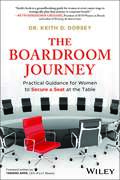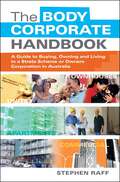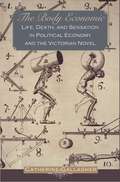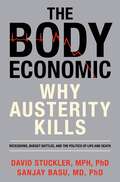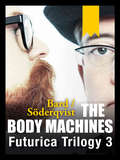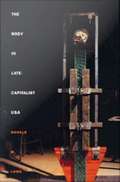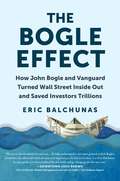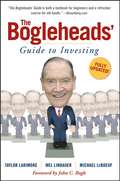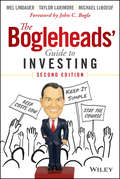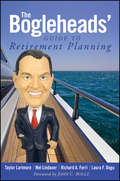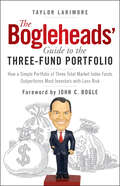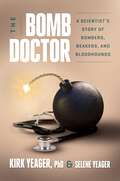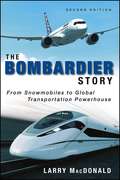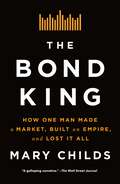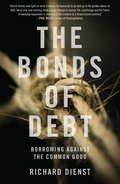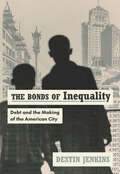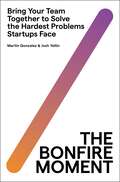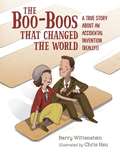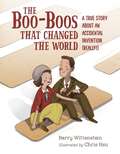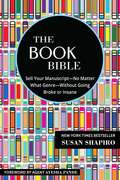- Table View
- List View
The Boardroom Journey: Practical Guidance for Women to Secure a Seat at the Table
by Keith D. DorseyEmpower your journey to the corporate boardroom with practical guidance and real-life examples. The Boardroom Journey: Practical Guidance for Women to Secure a Seat Table by Dr. Keith D. Dorsey offers a clear, actionable roadmap for women at any career stage to strategically build a path to the boardroom. The evidence-based strategies and inspiring success stories presented throughout this book have been gleaned from interviews with hundreds of current corporate board members. Specific tactics are outlined for early career professionals shaping their leadership journey, mid-career professionals navigating their way to the C-suite, and current and retired C-suite executives actively seeking their first (or next) corporate board seat. This book helps readers navigate the nuances of these journeys by moving from theoretical insights to actionable advice. The Boardroom Journey is an invaluable guide that helps women assess their personal motivations for career growth and board service, identify suitable boards, and enhance their board readiness through assessment tools and exercises. The book also offers strategies for building and leveraging a network of mentors, sponsors, and allies to gain support and boost confidence throughout the board journey. Inside the book: Discover strategies to effectively prepare for board service Gain insights on how to present and differentiate oneself via five types of capital Learn how to build and leverage a support team The Boardroom Journey is perfect for anyone aspiring to bring their unique perspective to corporate governance. The evidence-based strategies offered here give readers a proven method for charting an intentional path to executive service and securing a seat at the corporate boardroom table.
The Body Corporate Handbook: A Guide to Buying, Owning and Living in a Strata Scheme or Owners Corporation in Australia
by Stephen RaffPopulation growth, rising property prices and the dream of a new lifestyle have made body corporate living more and more popular in Australia. Living in an apartment, unit or townhouse can be a rewarding experience, but body corporate life can also be confusing. In this book, expert author Stephen Raff clarifies the rules and answers vital questions such as: What should I look out for when buying a strata property? What are the responsibilities of the body corporate, owners and tenants? How do committee meetings work? What fees will I have to pay? Who takes care of maintenance? What happens if I get into a dispute? Packed with revealing case studies and state-specific information, The Body Corporate Handbook is a comprehensive guide to every aspect of strata life for owner-occupiers, tenants and investors.
The Body Economic: Life, Death, and Sensation in Political Economy and the Victorian Novel
by Catherine GallagherThe Body Economic revises the intellectual history of nineteenth-century Britain by demonstrating that political economists and the writers who often presented themselves as their literary antagonists actually held most of their basic social assumptions in common. Catherine Gallagher demonstrates that political economists and their Romantic and early-Victorian critics jointly relocated the idea of value from the realm of transcendent spirituality to that of organic "life," making human sensations--especially pleasure and pain--the sources and signs of that value. Classical political economy, this book shows, was not a mechanical ideology but a form of nineteenth-century organicism, which put the body and its feelings at the center of its theories, and neoclassical economics built itself even more self-consciously on physiological premises. The Body Economic explains how these shared views of life, death, and sensation helped shape and were modified by the two most important Victorian novelists: Charles Dickens and George Eliot. It reveals how political economists interacted crucially with the life sciences of the nineteenth century--especially with psychophysiology and anthropology--producing the intellectual world that nurtured not only George Eliot's realism but also turn-of-the-century literary modernism.
The Body Economic: Why Austerity Kills
by Sanjay Basu David StucklerPoliticians have talked endlessly about the seismic economic and social impacts of the recent financial crisis, but many continue to ignore its disastrous effects on human health—and have even exacerbated them, by adopting harsh austerity measures and cutting key social programs at a time when constituents need them most. The result, as pioneering public health experts David Stuckler and Sanjay Basu reveal in this provocative book, is that many countries have turned their recessions into veritable epidemics, ruining or extinguishing thousands of lives in a misguided attempt to balance budgets and shore up financial markets. Yet sound alternative policies could instead help improve economies and protect public health at the same time. In The Body Economic, Stuckler and Basu mine data from around the globe and throughout history to show how government policy becomes a matter of life and death during financial crises. In a series of historical case studies stretching from 1930s America, to Russia and Indonesia in the 1990s, to present-day Greece, Britain, Spain, and the U. S. , Stuckler and Basu reveal that governmental mismanagement of financial strife has resulted in a grim array of human tragedies, from suicides to HIV infections. Yet people can and do stay healthy, and even get healthier, during downturns. During the Great Depression, U. S. deaths actually plummeted, and today Iceland, Norway, and Japan are happier and healthier than ever, proof that public wellbeing need not be sacrificed for fiscal health. Full of shocking and counterintuitive revelations and bold policy recommendations, The Body Economic offers an alternative to austerity—one that will prevent widespread suffering, both now and in the future.
The Body Machines
by Alexander Bard Jan SöderqvistThe final episode of The Futurica Trilogy. It departs from repeated questions about the Death of the Individual in the Age of Interactivity. The authors rehabilitate Descartes old concept of the body machine and transform it into the foundation of a very anti-cartesian, materialist image of humanity, relevant for the new, emerging paradigm--we're entering The Age of The Body Machines.
The Body in Late-Capitalist USA
by Donald M. LoweIn The Body in Late-Capitalist USA, Donald M. Lowe explores the varied social practices that code and construct the body. Arguing that our bodily lives are shaped by a complex of daily and ongoing practices--how we work, what we buy and consume--Lowe contends that as a result of the commodification of these and other social practices in the late-twentieth century, what we often understand to be the needs of the body are in fact means for capital accumulation. Moving beyond studies of representations and images of the body, Lowe focuses on the intersection of body practices, language, and the Social to describe concretely the reality of a lived body. His strongly synthetic work brings together Marxist critique, semiotics, Foucaultian discourse analysis, and systems and communications theory to examine those practices that construct the body under late capitalism: habits of work and consumption, the ways we give birth and raise children, socialization, mental and physical healing, reconstructions and contestations of sexuality and gender. Lowe draws upon a wide range of sources, including government and labor studies and statistics, diagnostic and statistical manuals on mental illness, computer manuals, self-help books, and guides to work-related stress disorders, to illustrate the transformation of the body into a nexus of exchange value in postmodern society.
The Body of Money: A Self-Help Guide to Creating Sustainable Wealth through Innate Intelligence
by Gayle ColmanIn a world gone mad with money The Body of Money: A Self-Help Guide to Create Sustainable Wealth through Innate Intelligence is a comprehensive guide to building and sustaining wealth by using the incredible intelligence of the human body. The story you’ve been told about money is all wrong. Spreadsheets, PNL’s, money markets, and index funds only touch the surface. The Body of Money provides a completely unique and effective approach to personal finance like nothing you’ve experienced before. By demystifying money psychology and behavior economics Certified Financial Planner® and Master Integral Coach™ Gayle Colman shows you exactly how to use your innate wisdom to heal old money patterns, tend to wounds created by generational financial trauma and create sustainable wealth that is aligned with your deepest values. Integrating cutting-edge research, laugh-out-loud storytelling and body-centered practices, Gayle puts the power of individual wealth–building squarely back in your own hands. You will learn: How body practices can have a transformative effect on your money habits. Where your personal money manager lives in your body and how to access its true wisdom. Why investing in a way that matches your personal values can actually be better for your health. How to use your body to gain true financial agency, reduce debt, invest in real estate and make the most important money decisions of your life. The Body of Money is an indispensable approach to personal finance, perfect for any person seeking relief from money struggles and all individuals and families who want to create a robust and healthy money legacy for their lives.
The Bogle Effect: How John Bogle and Vanguard Turned Wall Street Inside Out and Saved Investors Trillions
by Eric BalchunasThe index fund wouldn&’t be jack without Jack. It was just one innovation fueled by The Vanguard Group founder Jack Bogle&’s radical idea in 1975 to make investors the actual owners of his new fund company. While the move was as much to save his job as it was to save investors, the end result was powerful: a fund company for the people and by the people. Bogle began a 50-year process of lowering costs inch by inch, which ultimately unleashed a populist revolt that has saved average investors trillions of dollars while reforming and right-sizing much of the entire financial industry. Today, nearly every dollar invested in America goes to either Vanguard funds or Vanguard-influenced funds. But Bogle&’s impact and this &“great cost migration&” reaches well beyond index funds into many other areas, such as active management, ETFs, the advisory world, quantitative investing, ESG, behavioral finance and even trading platforms. The Bogle Effect takes readers through each of these worlds to show how they—and the investors they serve—are being reshaped and reformed. While hundreds of fund providers have copied the index fund that Vanguard made popular no one is yet to copy its &“mutual&” ownership structure. Why? This book explores that question as well as what made Bogle such an anomaly—seemingly immune to the overwhelming magnet of ambition that dictates Wall Street, made famous by movies like Wall Street, The Big Short, and The Wolf of Wall Street. On the flip side, Bogle wasn&’t perfect by any stretch—he could be moralizing, cantankerous, and tended to make virtue out of necessity. The Bogle Effect is animated by the author&’s hours of one-on-one, exclusive interviews with Bogle in the years before he passed, which reveal his philosophy, vision, intellect, and humor. Dozens of additional interviews with people who worked with him, lived with him, were influenced by him, and disagreed with him round out a portrait of this revolutionary figure. You will never look at the financial industry or your portfolio the same way again.
The Bogleheads' Guide to Investing
by John C. Bogle Taylor Larimore Mel Lindauer Michael LeboeufThe Bogleheads' Guide to Investing is a slightly irreverent, straightforward guide to investing for everyone. The book offers sound, practical advice, no matter what your age or net worth. Bottomline, become a Boglehead and prosper! Originally just the chat-line ruminations of Boglehead founder Taylor Larimore, and Morningstar forum leading cohorts Mel Lindauer and Michael LeBoeuf, their trusted advice has been brewed and distilled into an easy-to-use, need-to-know, no frills guide to building up your own financial well-being - so you can worry less and profit more from the investments you make. Invest like a Boglehead, and let their grassroots investment wisdom guide you down the path of long-term wealth creation and happiness, without all the worries and fuss of stock pickers and day traders. If you face a financial crisis or problem, or simply want to know what is prudent to do with the money you save, the Bogleheads will have the answers you need to help you gain your financial footing and keep it.
The Bogleheads' Guide to Investing: Second Edition
by Taylor Larimore Mel Lindauer Michael LeBoeufThe irreverent guide to investing, Boglehead style The Boglehead's Guide to Investing is a DIY handbook that espouses the sage investment wisdom of John C. Bogle. This witty and wonderful book offers contrarian advice that provides the first step on the road to investment success, illustrating how relying on typical "common sense" promoted by Wall Street is destined to leave you poorer. This updated edition includes new information on backdoor Roth IRAs and ETFs as mainstream buy and hold investments, estate taxes and gifting, plus changes to the laws regarding Traditional and Roth IRAs, and 401k and 403b retirement plans. With warnings and principles both precisely accurate and grandly counterintuitive, the Boglehead authors show how beating the market is a zero-sum game. Investing can be simple, but it's certainly not simplistic. Over the course of twenty years, the followers of John C. Bogle have evolved from a loose association of investors to a major force with the largest and most active non-commercial financial forum on the Internet. The Boglehead's Guide to Investing brings that communication to you with comprehensive guidance to the investment prowess on display at Bogleheads.org. You'll learn how to craft your own investment strategy using the Bogle-proven methods that have worked for thousands of investors, and how to: Choose a sound financial lifestyle and diversify your portfolio Start early, invest regularly, and know what you're buying Preserve your buying power, keeping costs and taxes low Throw out the "good" advice promoted by Wall Street that leads to investment failure Financial markets are essentially closed systems in which one's gain garners another's loss. Investors looking for a roadmap to successfully navigating these choppy waters long-term will find expert guidance, sound advice, and a little irreverent humor in The Boglehead's Guide to Investing.
The Bogleheads' Guide to Retirement Planning
by John C. Bogle Taylor Larimore Laura F. Dogu Mel Lindauer Richard A. FerriThe Bogleheads are back-with retirement planning advice for those who need it!Whatever your current financial situation, you must continue to strive for a viable retirement plan by finding the most effective ways to save, the best accounts to save in, and the right amount to save, as well as understanding how to insure against setbacks and handle the uncertainties of a shaky economy.Fortunately, the Bogleheads, a group of like-minded individual investors who follow the general investment and business beliefs of John C. Bogle, are here to help. Filled with valuable advice on a wide range of retirement planning issues, including some pearls of wisdom from Bogle himself, The Bogleheads' Guide to Retirement Planning has everything you need to succeed at this endeavor.Explains the different types of savings accounts and retirement plansOffers insights on managing and funding your retirement accountsDetails efficient withdrawal strategies that could help you maintain a comfortable retirement lifestyleAddresses essential estate planning and gifting issuesWith The Bogleheads' Guide to Retirement Planning, you'll discover exactly what it takes to secure your financial future, today.
The Bogleheads' Guide to the Three-Fund Portfolio: How a Simple Portfolio of Three Total Market Index Funds Outperforms Most Investors with Less Risk
by John C. Bogle Taylor LarimoreTwenty benefits from the three-fund total market index portfolio. The Bogleheads’ Guide to The Three-Fund Portfolio describes the most popular portfolio on the Bogleheads forum. This all-indexed portfolio contains over 15,000 worldwide securities, in just three easily-managed funds, that has outperformed the vast majority of both professional and amateur investors. If you are a new investor, or an experienced investor who wants to simplify and improve your portfolio, The Bogleheads’ Guide to The Three-Fund Portfolio is a short, easy-to-read guide to show you how.
The Bomb Doctor: A Scientist's Story of Bombers, Beakers, and Bloodhounds
by Selene Yeager Kirk YeagerA rare peek behind the curtain into boots-on-the-ground, in-the-lab scientific bomb forensics—told with humanity, heart, and even a bit of humor.This is not CSI. What you encounter as a true bomb detective—or &“Bomb Doctor,&” as some in the FBI call me—are fields of twisted metal containing soot-covered fragments intermingled with human remains. You have carnage and chaos. As you wade into that sea of wailing sirens and screaming survivors awash with the stench of diesel fuel and decaying bodies, your job is to ferret out forensic clues in a type of macabre scavenger hunt to ultimately reconstruct the scene and the explosive device and determine what happened and what the bomb looked like before it was torn asunder. None of this happens overnight. Nor does it happen in a timeframe that can be neatly packaged in an hour-long made-for-TV drama. The scavenger hunt can take months—or, in the case of the infamous Collar Bomber, seven painstaking years. The work is worth every second and every horrific image that etches itself into your brain because it helps prevent new horrors. Not all, obviously. We are not superheroes. But unlike shooters, who often just &“snap&” or seem to act out in random ways, bombers almost always have a story—one that follows an arc. In The Bomb Doctor, my goal is to explain that arc, explode myths, reconstruct reality, and build an understanding of the reason and means behind the mayhem, as well as pull back the curtain on the investigative process that brings bombers to justice.
The Bombardier Story: From Snowmobiles to Global Transportation Powerhouse
by Larry MacDonaldThe story of the company that was founded by the inventor of the snowmobile In 1942, Joseph-Armand Bombardier invented the snowmobile and founded his company to manufacture them. From its humble beginnings as an entrepreneurial company in rural Quebec, led by an enterprising inventor, Bombardier Inc. has emerged as a global leader in the transportation industry. This book tells the fascinating tale of this remarkably well managed company that has enjoyed spectacular growth in its chosen markets through strong leadership and management strategy, succession planning, strategic diversification, and turnaround and acquisition artistry. The fascinating story of the world's largest rail manufacturer for both railway and subway Reveals why Bombardier Inc. is a multi-faceted global company yet nobody knows their name Written by Larry MacDonald the author of Nortel Network The Bombardier Story shows how invention and entrepreneurship, management and leadership, smooth succession planning, and turnaround and acquisition built this global powerhouse.
The Bombardier Story: From Snowmobiles to Global Transportation Powerhouse (Second Edition)
by Larry MacdonaldThe story of the company that was founded by the inventor of the snowmobile<p><p> In 1942, Joseph-Armand Bombardier invented the snowmobile and founded his company to manufacture them. From its humble beginnings as an entrepreneurial company in rural Quebec, led by an enterprising inventor, Bombardier Inc. has emerged as a global leader in the transportation industry. This book tells the fascinating tale of this remarkably well managed company that has enjoyed spectacular growth in its chosen markets through strong leadership and management strategy, succession planning, strategic diversification, and turnaround and acquisition artistry. <p> - The fascinating story of the world's largest rail manufacturer for both railway and subway<br> - Reveals why Bombardier Inc. is a multi-faceted global company yet nobody knows their name<br> - Written by Larry MacDonald the author of Nortel Network <p> The Bombardier Story shows how invention and entrepreneurship, management and leadership, smooth succession planning, and turnaround and acquisition built this global powerhouse.
The Bond King: How One Man Made a Market, Built an Empire, and Lost It All
by Mary ChildsFrom the host of NPR’s Planet Money, the deeply-investigated story of how one visionary, dogged investor changed American finance forever.Before Bill Gross was known among investors as the Bond King, he was a gambler. In 1966, a fresh college grad, he went to Vegas armed with his net worth ($200) and a knack for counting cards. $10,000 and countless casino bans later, he was hooked: so he enrolled in business school.The Bond King is the story of how that whiz kid made American finance his casino. Over the course of decades, Bill Gross turned the sleepy bond market into a destabilized game of high risk, high reward; founded Pimco, one of today’s most powerful, secretive, and cutthroat investment firms; helped to reshape our financial system in the aftermath of the Great Recession—to his own advantage; and gained legions of admirers, and enemies, along the way. Like every American antihero, his ambition would also be his undoing.To understand the winners and losers of today’s money game, journalist Mary Childs argues, is to understand the bond market—and to understand the bond market is to understand the Bond King.
The Bonds of Debt: Borrowing Against the Common Good
by Richard DienstThe credit crisis has pushed the whole world so far into the red that the gigantic sums involved defy understanding. On a human level, what does such an enormous degree of debt and insolvency mean? In this timely book, cultural critic Richard Dienst considers the financial crisis, global poverty, media politics and radical theory to parse the various implications of a world where man is born free but everywhere is in debt.Written with humor and verve, Bonds of Debt ranges across subjects—such as Obama’s national security strategy, the architecture of Prada stores, press photos of Bono, and a fairy tale told by Karl Marx—to capture a modern condition founded on fiscal imprudence. Moving beyond the dominant pieties and widespread anxieties surrounding the topic, Dienst re-conceives the world’s massive financial obligations as a social, economic, and political bond, where the crushing weight of objectified wealth comes face to face with new demands for equality and solidarity. For this inspired analysis, we are indebted to him.
The Bonds of Inequality: Debt and the Making of the American City
by Destin JenkinsIndebtedness, like inequality, has become a ubiquitous condition in the United States. Yet few have probed American cities’ dependence on municipal debt or how the terms of municipal finance structure racial privileges, entrench spatial neglect, elide democratic input, and distribute wealth and power. In this passionate and deeply researched book, Destin Jenkins shows in vivid detail how, beyond the borrowing decisions of American cities and beneath their quotidian infrastructure, there lurks a world of politics and finance that is rarely seen, let alone understood. Focusing on San Francisco, The Bonds of Inequality offers a singular view of the postwar city, one where the dynamics that drove its creation encompassed not only local politicians but also banks, credit rating firms, insurance companies, and the national municipal bond market. Moving between the local and the national, The Bonds of Inequality uncovers how racial inequalities in San Francisco were intrinsically tied to municipal finance arrangements and how these arrangements were central in determining the distribution of resources in the city. By homing in on financing and its imperatives, Jenkins boldly rewrites the history of modern American cities, revealing the hidden strings that bind debt and power, race and inequity, democracy and capitalism.
The Bonds of Inequality: Debt and the Making of the American City
by Destin JenkinsIndebtedness, like inequality, has become a ubiquitous condition in the United States. Yet few have probed American cities’ dependence on municipal debt or how the terms of municipal finance structure racial privileges, entrench spatial neglect, elide democratic input, and distribute wealth and power. In this passionate and deeply researched book, Destin Jenkins shows in vivid detail how, beyond the borrowing decisions of American cities and beneath their quotidian infrastructure, there lurks a world of politics and finance that is rarely seen, let alone understood. Focusing on San Francisco, The Bonds of Inequality offers a singular view of the postwar city, one where the dynamics that drove its creation encompassed not only local politicians but also banks, credit rating firms, insurance companies, and the national municipal bond market. Moving between the local and the national, The Bonds of Inequality uncovers how racial inequalities in San Francisco were intrinsically tied to municipal finance arrangements and how these arrangements were central in determining the distribution of resources in the city. By homing in on financing and its imperatives, Jenkins boldly rewrites the history of modern American cities, revealing the hidden strings that bind debt and power, race and inequity, democracy and capitalism.
The Bonfire Moment: Bring Your Team Together to Solve the Hardest Problems Startups Face
by Martin Gonzalez Joshua YellinAN INTERNATIONAL BESTSELLERUnique insights from pioneers of Google’s Startup Accelerator on why building teams is harder than building tech—and a proven way to develop a strong, resilient and effective team.Most startups fail not because of a bad product, poor timing, or mismanaged cash, but because of people problems: conflicts over strategy, decision-making, and team culture. Even the smartest entrepreneurs have been derailed by these soft problems: How do you fire a loyal friend who’s not up to par? How do you motivate your team to give their all? What happens when egos and emotions overpower facts and reason? The soft stuff can be shockingly hard.Martin Gonzalez and Josh Yellin outline the common traps startup teams fall into, and share their powerful one-day workshop that helps teams escape those traps. The unique process of The Bonfire Moment brings colleagues together for a full day of facing hard truths, noticing hidden dynamics, and gearing up for the intense challenges of startup life. When the constant hustle feels overwhelming, a team’s Bonfire Moment pulls them out of the day-to-day intensity to reflect and reboot.The Bonfire Moment has proven effective with hundreds of teams of all sizes around the world—from the smallest startups to large organizations—significantly improving their cohesion, focus and effectiveness. Now this book will teach leaders the principles behind The Bonfire Moment and how to run the workshop on their own. It's ideal for anyone who needs to build an extraordinary team to achieve big goals.
The Boo-Boos That Changed the World: A True Story About An Accidental Invention (really!)
by Barry WittensteinThe true story of Earl Dickson inventing Band Aid for his injury prone wife, Josephine.
The Boo-Boos That Changed the World: A True Story About an Accidental Invention (Really!)
by Barry WittensteinDid you know Band-Aids were invented by accident?! And that they weren't mass-produced until the Boy Scouts gave their seal of approval?1920s cotton buyer Earle Dickson worked for Johnson & Johnson and had a klutzy wife who often cut herself. The son of a doctor, Earle set out to create an easier way for her to bandage her injuries. Band-Aids were born, but Earle's bosses at the pharmaceutical giant weren't convinced, and it wasn't until the Boy Scouts of America tested Earle's prototype that this ubiquitous household staple was made available to the public. Soon Band-Aids were selling like hotcakes, and the rest is boo-boo history."Appealingly designed and illustrated, an engaging, fun story" — Kirkus Reviews STARRED REVIEW
The Book Bible: How to Sell Your Manuscript—No Matter What Genre—Without Going Broke or Insane
by Susan ShapiroA Brilliant, Buoyant Guide to Publishing Your Book Hundreds of thousands of books come out every year worldwide. So why not yours? In The Book Bible, New York Times bestseller and wildly popular Manhattan writing professor Susan Shapiro reveals the best and fastest ways to break into a mainstream publishing house. Unlike most writing manuals that stick to only one genre, Shapiro maps out the rules of all the sought-after, sellable categories: novels, memoirs, biography, how-to, essay collections, anthologies, humor, mystery, crime, poetry, picture books, young adult and middle grade, fiction and nonfiction. Shapiro once worried that selling 16 books in varied sub-sections made her a literary dabbler. Yet after helping her students publish many award-winning bestsellers on all shelves of the bookstore, she realized that her versatility had a huge upside. She could explain, from personal experience, the differences in making each kind of book, as well as ways to find the right genre for every project and how to craft a winning proposal or great cover letter to get a top agent and book editor to say yes. This valuable guide will teach both new and experienced scribes how to attain their dream of becoming a successful author.
The Book Deal: Confidential Instructions for the AGENT
by Max H. Bazerman Deepak MalhotraA two-party negotiation between an Agent representing a new author and an Editor at a large Publishing Firm. The exercise involves a 1-issue, zero-sum negotiation concerning the advance on royalties that the publisher will pay to the author.
The Book Deal: Confidential Instructions for the AGENT
by Max H. Bazerman Deepak MalhotraA two-party negotiation between an Agent representing a new author and an Editor at a large Publishing Firm. The exercise involves a 1-issue, zero-sum negotiation concerning the advance on royalties that the publisher will pay to the author.
